Investigation of the Environmentally-Friendly Refrigerant R152a for Air Conditioning Purposes
Abstract
1. Introduction
2. Material and Methods
2.1. Examined System
2.2. Mathematical Formulation
2.3. Methodology of the Present Study
2.4. Model Validation
3. Results and Discussion
3.1. Impact of the Rotational Speed on the Performance
3.2. Impact of the Ambient Temperature on the Performance
3.3. Impact of the Indoor Temperature on the Performance
3.4. Deeper Analysis of the Examined Heat Pump
- Cooling capacity correlation (R2 = 99.19%)
- COP correlation (R2 = 96.47%)
- (a)
- (b)
3.5. Comparative Study with Other Refrigerants
4. Conclusions
- -
- In the nominal operating conditions, the examined heat pump has 5 kW cooling capacity and a COP equal to 6.46.
- -
- The increase of the rotational speed leads to higher cooling capacity and to lower COP.
- -
- The increase of the ambient temperature leads to lower cooling capacity and to lower COP.
- -
- The increase of the indoor temperature leads to higher cooling capacity and to higher COP.
- -
- It is found that the rotational speed is the most important parameter for the cooling capacity value, while the ambient temperature is the most important parameter for the COP value.
- -
- The R152a is found to be the most efficient refrigerant compared to six other refrigerants. The mean enhancement with the R600a is found to be 1.14%, while with R134a 4.36%, while with the R404a 20.20%.
- -
- The final results of this work can be utilized for the proper modeling of a cooling system with a heat pump with R152a. The developed models can be utilized for the simulation of this system in different operating conditions. Moreover, the advantages of the R152a are discussed and explained in this work and finally, this refrigerant is suggested as a reliable choice.
Author Contributions
Funding
Conflicts of Interest
Nomenclature
| COP | Coefficient of performance, - | |
| cp | Specific heat capacity, J/kgK | |
| h | Specific enthalpy, J/kg | |
| m | Mass flow rate, kg/s | |
| n | Rotational speed, rpm | |
| p | Pressure, bar | |
| Pel | Electricity consumption, W | |
| Q | Heat rate, W | |
| r | Compressor pressure ratio, - | |
| (UA) | Total transmittance, W/K | |
| Vdis | Compressor displacement volume, m3/r | |
| W | Work consumption, W | |
| Greek symbols | ||
| ηc | Condenser heat exchanger effectiveness, - | |
| ηe | Evaporator heat exchanger effectiveness, - | |
| ηis | Compressor isentropic efficiency, - | |
| ηm | Motor efficiency, - | |
| ηv | Compressor volumetric efficiency, - | |
| Subscripts and superscripts | ||
| amb | Ambient | |
| c | Condenser | |
| c,in | Inlet condenser | |
| c,out | Outlet condenser | |
| e | Evaporator | |
| e,in | Inlet evaporator | |
| e,out | Outlet evaporator | |
| ind | Indoor | |
| is | Isentropic | |
| high | High | |
| Low | Low | |
| r | Refrigerant | |
| Abbreviations | ||
| EES | Engineering Equation Solver | |
| GWP | Global Warming Potential | |
References
- Ciconkov, R. Refrigerants. There is still no vision for sustainable solutions. Int. J. Refrig. 2018, 86, 441–448. [Google Scholar] [CrossRef]
- Khanmohammadi, S.; Goodarzi, M.; Khanmohammadi, S.; Ganjehsarabi, H. Thermoeconomic modeling and multi-objective evolutionary-based optimization of a modified transcritical CO2 refrigeration cycle. Therm. Sci. Eng. Prog. 2018, 5, 86–96. [Google Scholar] [CrossRef]
- Piccolo, A.; Siclari, R.; Rando, F.; Cannistraro, M. Comparative Performance of Thermoacoustic Heat Exchangers with Different Pore Geomeyries in Oscillatory Flow Implementation of Experimental Techniques. Appl. Sci. 2017, 2, 784. [Google Scholar] [CrossRef]
- Cannistraro, M.; Mainardi, E.; Bottarelli, M. Testing a Dual-Source Heat Pump. Math. Model. Eng. Probl. 2018, 5, 197–204. [Google Scholar] [CrossRef]
- Regulation, EU No 517/2014 of the European Parliament and the Council of 16 April 2014 on Fluorinated Greenhouse Gases and Repealing Regulation (EC) No 842/2006. Available online: http//www.eea.europa.eu/policy-documents/regulation-eu-no-517-2014 (accessed on 30 December 2018).
- IPCC. Climate Change 2013, The Physical Science Basis. Contribution of Working Group I to the Fifth Assessment Report of the Intergovernmental Panel on Climate Change, 1st ed.; Cambridge University Press: New York, NY, USA, 2013. [Google Scholar]
- Abas, N.; Kalair, A.R.; Khan, N.; Haider, A.; Saleem, Z.; Saleem, M.S. Natural and synthetic refrigerants, global warming, A review. Renew. Sustain. Energy Rev. 2018, 90, 557–569. [Google Scholar] [CrossRef]
- Available online: https//en.wikipedia.org/wiki/List_of_refrigerants (accessed on 5 November 2018).
- McLinden, M.; Steven Brown, J.; Brignoli, R.; Kazakov, A.; Domanski, P. Limited options for low-global-warming-potential refrigerants. Nat. Commun. 2017, 8, 14476. [Google Scholar] [CrossRef]
- Tsamos, K.M.; Ge, Y.T.; Santosa, I.; Tassou, S.A.; Bianchi, G.; Mylona, Z. Energy analysis of alternative CO2 refrigeration system configurations for retail food applications in moderate and warm climates. Energy Convers. Manag. 2017, 150, 822–829. [Google Scholar] [CrossRef]
- Gullo, P.; Elmegaard, B.; Cortella, G. Energy and environmental performance assessment of R744 booster supermarket refrigeration systems operating in warm climates. Int. J. Refrig. 2016, 64, 61–79. [Google Scholar] [CrossRef]
- Bolaji, B.O. Experimental study of R152a and R32 to replace R134a in a domestic refrigerator. Energy 2010, 35, 3793–3798. [Google Scholar] [CrossRef]
- Nie, J.; Li, Z.; Kong, X.; Li, D. Analysis and Comparison Study on Different HFC Refrigerants for Space Heating Air Source Heat Pump in Rural Residential Buildings of North China. Procedia Eng. 2017, 205, 1201–1206. [Google Scholar] [CrossRef]
- Cabello, R.; Sánchez, D.; Llopis, R.; Arauzo, I.; Torrella, E. Experimental comparison between R152a and R134a working in a refrigeration facility equipped with a hermetic compressor. Int. J. Refrig. 2015, 60, 92–105. [Google Scholar] [CrossRef]
- Sanchez, D.; Cabello, R.; Llopis, R.; Arauzo, I.; Catalán-Gil, J.; Torrella, E. Energy performance evaluation of R1234yf, R1234ze(E), R600a, R290 and R152a as low-GWP R134a alternatives. Int. J. Refrig. 2017, 74, 269–282. [Google Scholar] [CrossRef]
- Perez-Garcia, V.; Belman-Flores, J.N.; Rodríguez-Munoz, L.J.; Rangel-Hernandez, V.H.; Gallegos-Munoz, A. Second Law Analysis of a Mobile Air Conditioning System with Internal Heat Exchanger Using Low GWP Refrigerants. Entropy 2017, 19, 175. [Google Scholar] [CrossRef]
- Cabello, R.; Sánchez, D.; Llopis, R.; Catalán, J.; Nebot-Andrés, L.; Torrella, E. Energy evaluation of R152a as drop in replacement for R134a in cascade refrigeration plants. Appl. Therm. Eng. 2017, 110, 972–984. [Google Scholar] [CrossRef]
- Yang, W.-W.; Cao, X.-Q.; He, Y.-l.; Yan, F.-Y. Theoretical study of a high-temperature heat pump system composed of a CO2 transcritical heat pump cycle and a R152a subcritical heat pump cycle. Appl. Therm. Eng. 2017, 120, 228–238. [Google Scholar] [CrossRef]
- F-Chart Software, Engineering Equation Solver (EES), 2015. Available online: http//www. fchart.com/ees (accessed on 30 December 2018).
- Underwood, C.P. 14—Heat pump modelling. Advances in Ground-Source Heat Pump Systems; Rees, S.J., Ed.; Woodhead Publishing: Sawston, UK, 2016; pp. 387–421. [Google Scholar]
- Goncalves, J.M.; Melo, C.; Hermes, C.J.L. A semi-empirical model for steady-state simulation of household refrigerators. Appl. Therm. Eng. 2009, 29, 1622–1630. [Google Scholar] [CrossRef]
- Bellos, E.; Vrachopoulos, M.G.; Tzivanidis, C. Energetic and exergetic investigation of a novel solar assisted mechanical compression refrigeration system. Energy Convers. Manag. 2017, 147, 1–18. [Google Scholar] [CrossRef]
- Bellos, E.; Tzivanidis, C.; Tsifis, G. Energetic, Exergetic, Economic and Environmental (4E) analysis of a solar assisted refrigeration system for various operating scenarios. Energy Convers. Manag. 2017, 148, 1055–1069. [Google Scholar] [CrossRef]
- Brown, J.S.; Yana-Motta, S.F.; Domanski, P.A. Comparitive analysis of an automotive air conditioning systems operating with CO2 and R134a. Int. J. Refrig. 2002, 25, 19–32. [Google Scholar] [CrossRef]
- Djuric, N.; Novakovic, V.; Frydenlund, F. Improved measurements for better decision on heat recovery solutions with heat pumps. Int. J. Refrig. 2012, 35, 1558–1569. [Google Scholar] [CrossRef]
- Djuric, N.; Huang, G.; Novakovic, V. Data fusion heat pump performance estimation. Energy Build. 2011, 43, 621–630. [Google Scholar] [CrossRef]
- Negrao, C.O.R.; Erthal, R.H.; Andrade, D.E.V.; Wasnievski da Silva, L. A semi-empirical model for the unsteady-state simulation of reciprocating compressors for household refrigeration applications. Appl. Therm. Eng. 2011, 31, 1114–1124. [Google Scholar] [CrossRef]
- Llopis, R.; Nebot-Andrés, L.; Cabello, R.; Sánchez, D.; Catalán-Gil, J. Experimental evaluation of a CO2 transcritical refrigeration plant with dedicated mechanical subcooling. Int. J. Refrig. 2016, 69, 361–368. [Google Scholar] [CrossRef]
- Chen, J.; Yu, J. Theoretical analysis on a new direct expansion solar assisted ejector-compression heat pump cycle for water heater. Sol. Energy 2017, 142, 299–307. [Google Scholar] [CrossRef]
- Llopis, R.; Sánchez, D.; Cabello, R.; Catalán-Gil, J.; Nebot-Andrés, L. Conversion of a Direct to an Indirect Refrigeration System at Medium Temperature Using R-134a and R-507A, An Energy Impact Analysis. Appl. Sci. 2018, 8, 247. [Google Scholar] [CrossRef]
- Bellos, E.; Tzivanidis, C.; Symeou, C.; Antonopoulos, K.A. Energetic, exergetic and financial evaluation of a solar driven absorption chiller—A dynamic approach. Energy Convers. Manag. 2017, 137, 34–48. [Google Scholar] [CrossRef]
- Panaras, G.; Mathioulakis, E.; Belessiotis, V. A semi-analytical refrigeration cycle modelling approach for a heat pump hot water heater. Int. J. Sustain. Energy 2018, 37, 393–414. [Google Scholar] [CrossRef]
- Catalán-Gil, J.; Sánchez, D.; Llopis, R.; Nebot-Andrés, L.; Cabello, R. Energy Evaluation of Multiple Stage Commercial Refrigeration Architectures Adapted to F-Gas Regulation. Energies 2018, 11, 1915. [Google Scholar] [CrossRef]
- Nebot-Andrés, L.; Llopis, R.; Sánchez, D.; Catalán-Gil, J.; Cabello, R. CO2 with Mechanical Subcooling vs. CO2 Cascade Cycles for Medium Temperature Commercial Refrigeration Applications Thermodynamic Analysis. Appl. Sci. 2017, 7, 955. [Google Scholar] [CrossRef]
- Rahmani-Andebili, M. Stochastic, adaptive, and dynamic control of energy storage systems integrated with renewable energy sources for power loss minimization. Renew. Energy 2017, 113, 1462–1471. [Google Scholar] [CrossRef]
- Rahmani-Andebili, M. Scheduling deferrable appliances and energy resources of a smart home applying multi-time scale stochastic model predictive control. Sustain. Cities Soc. 2017, 32, 338–347. [Google Scholar] [CrossRef]
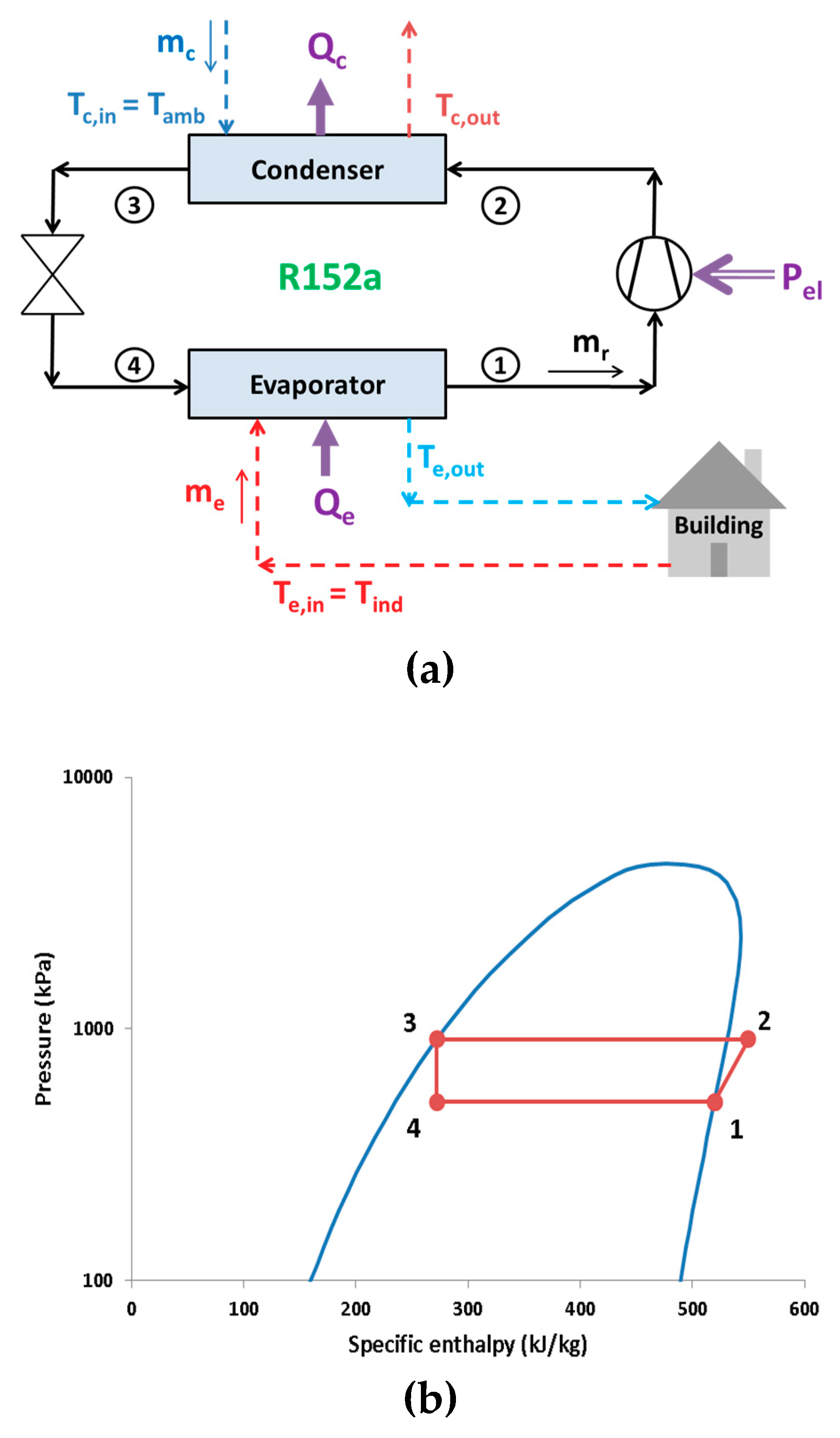
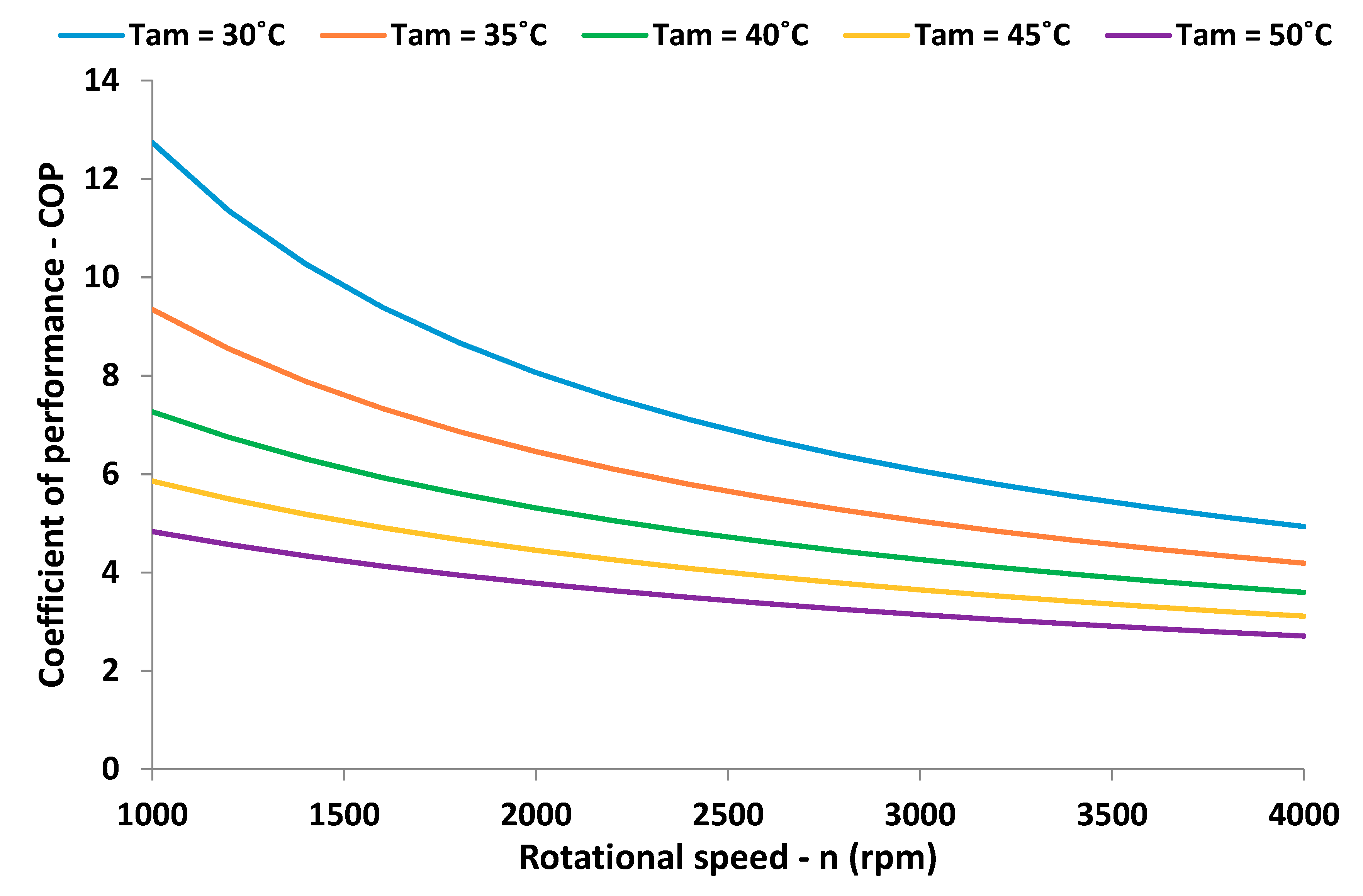
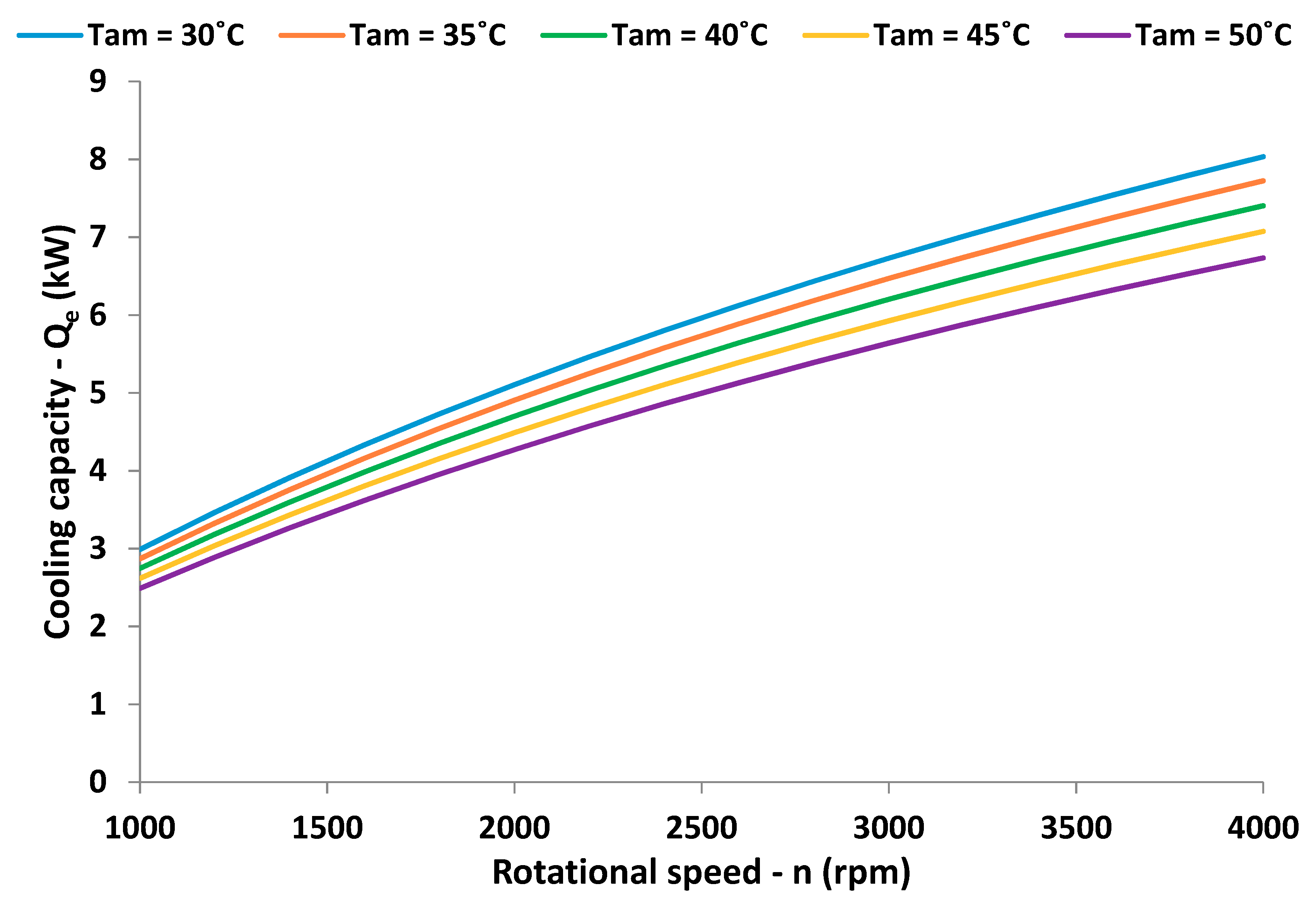
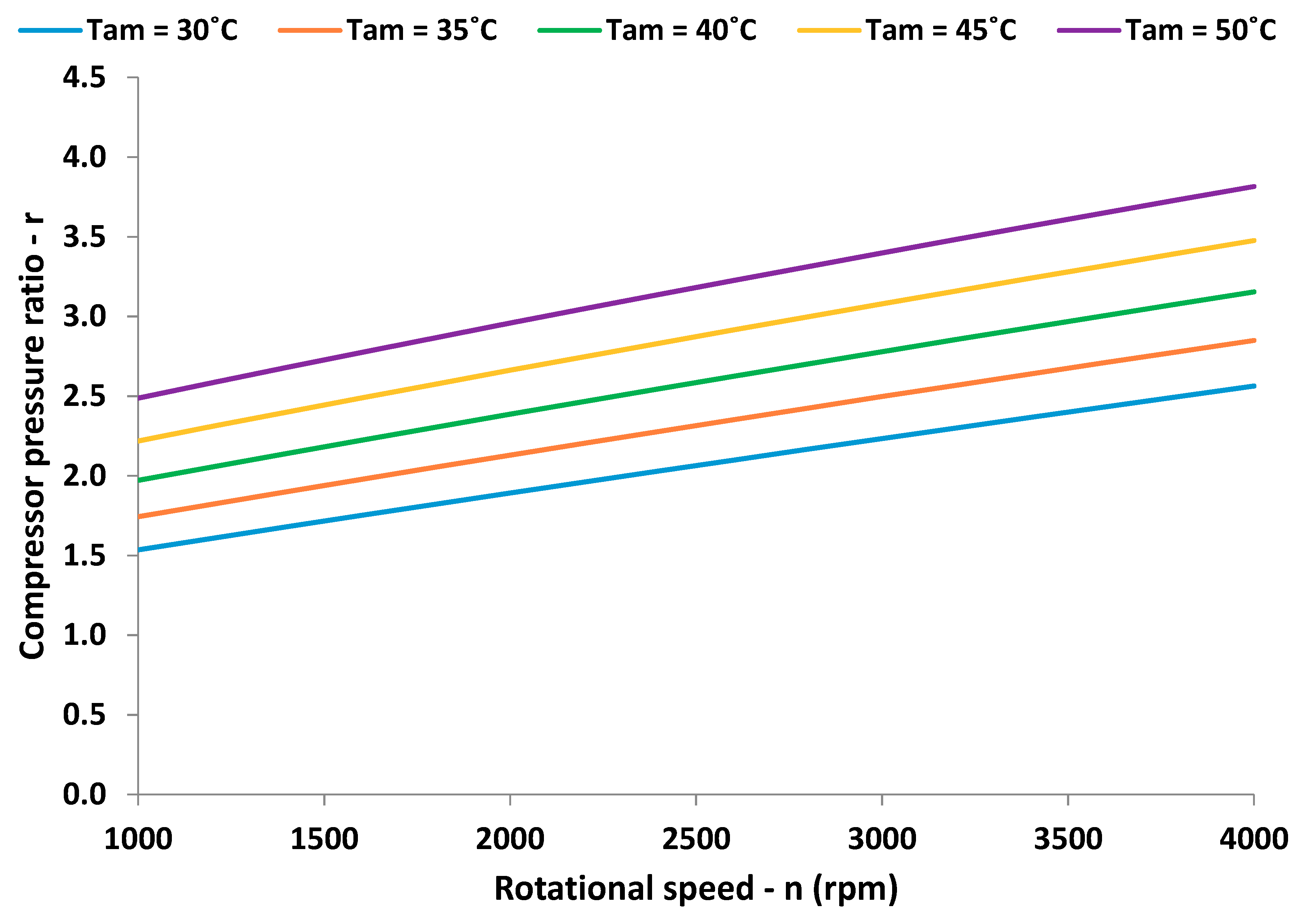
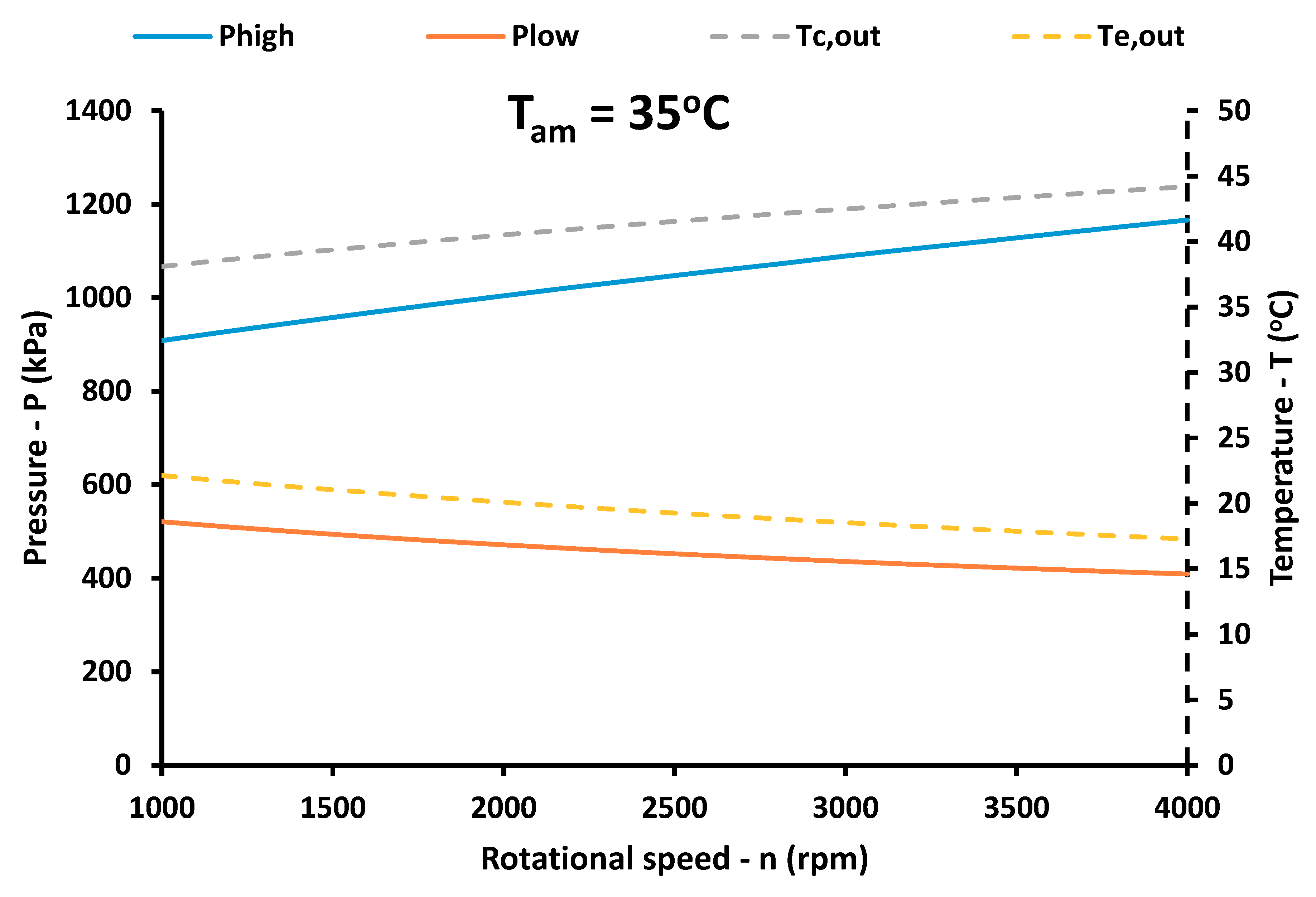
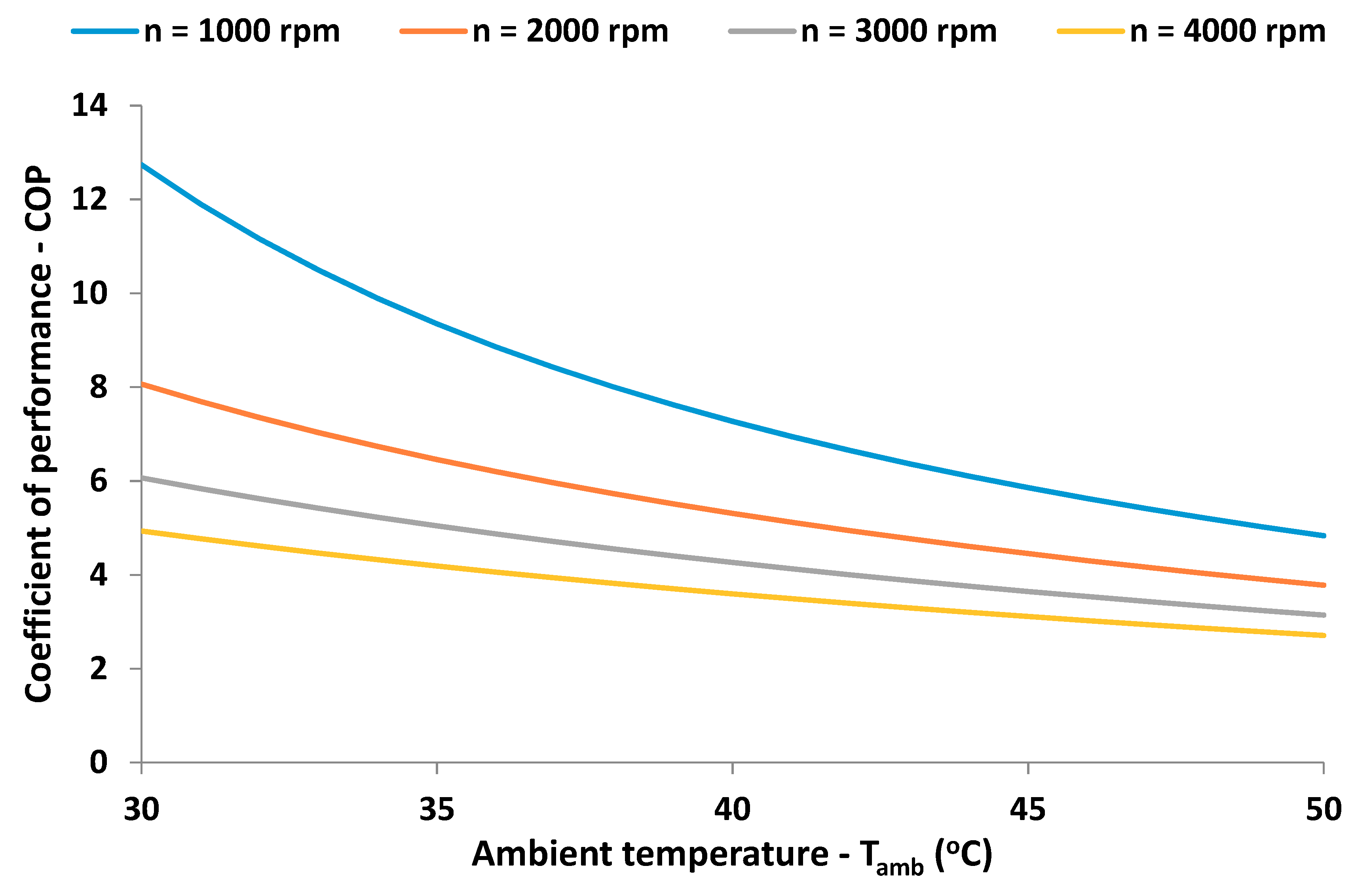
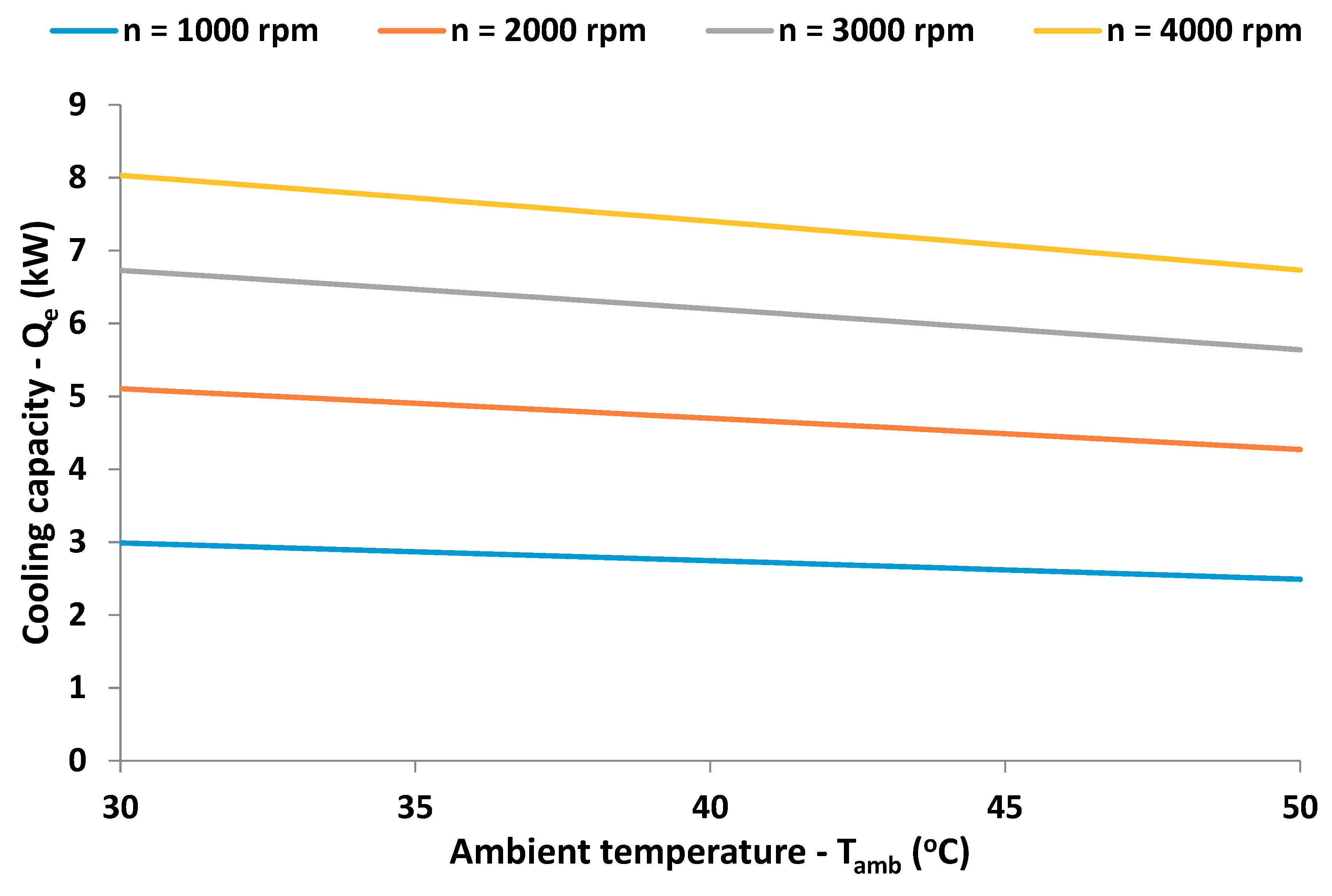
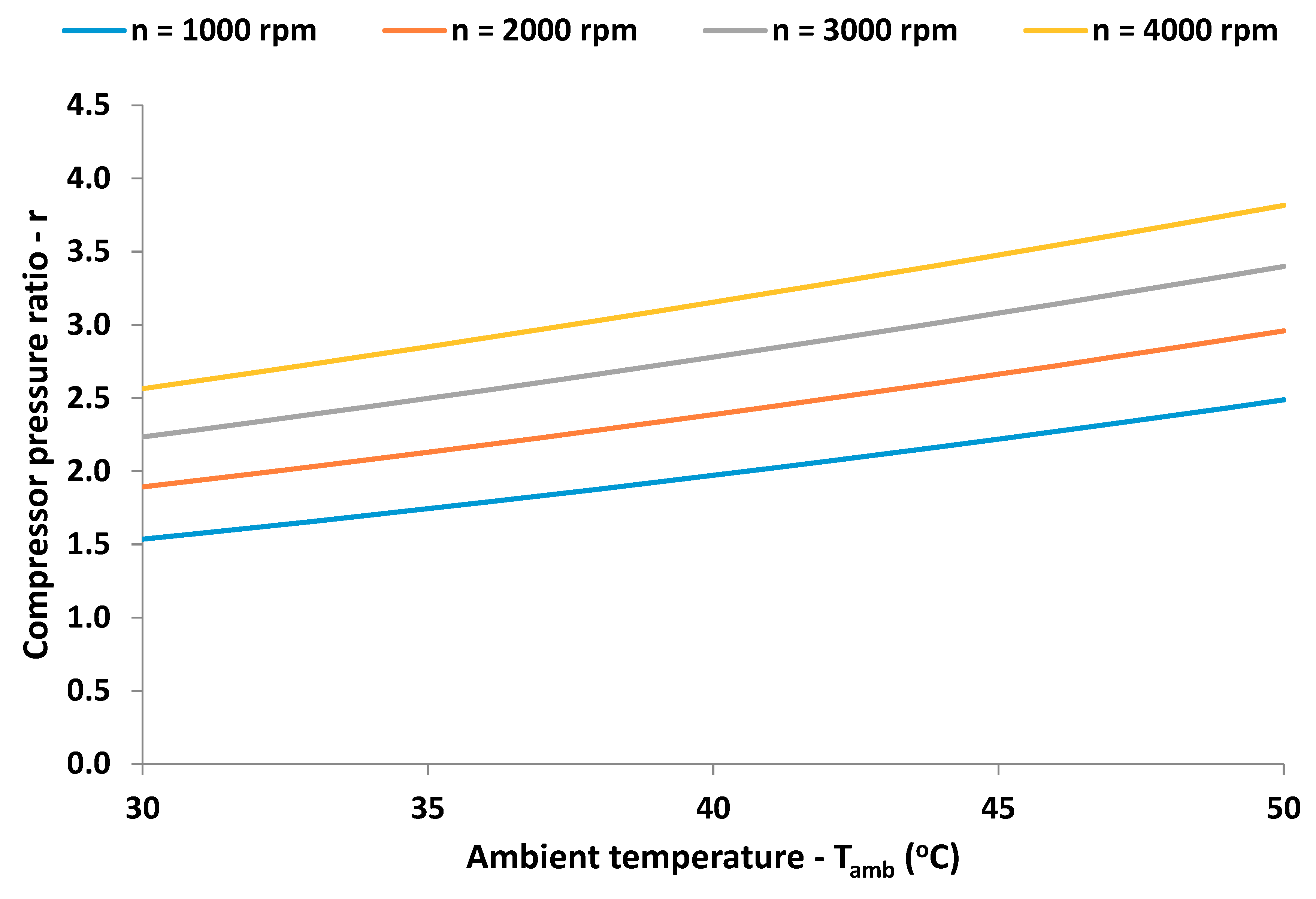
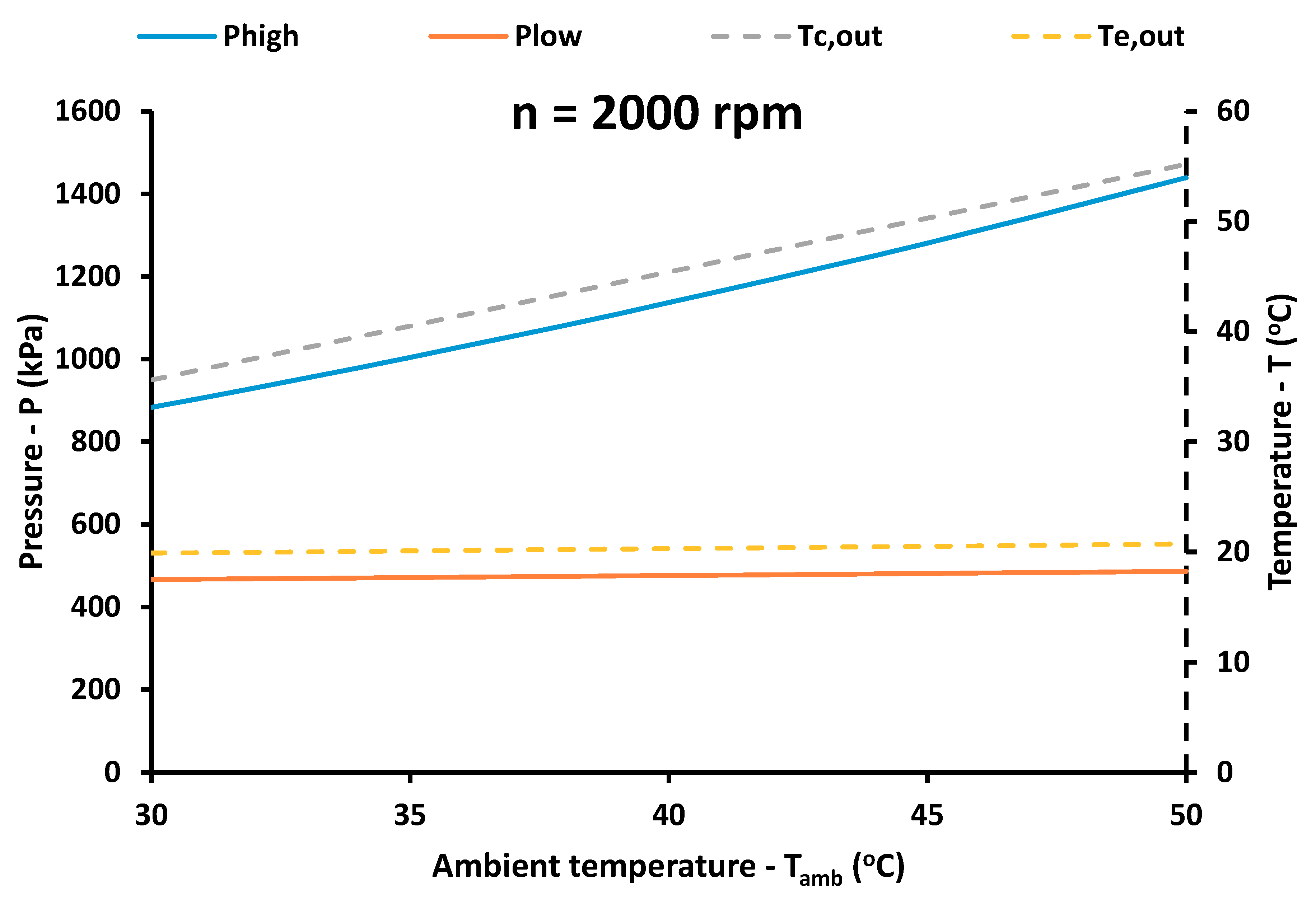
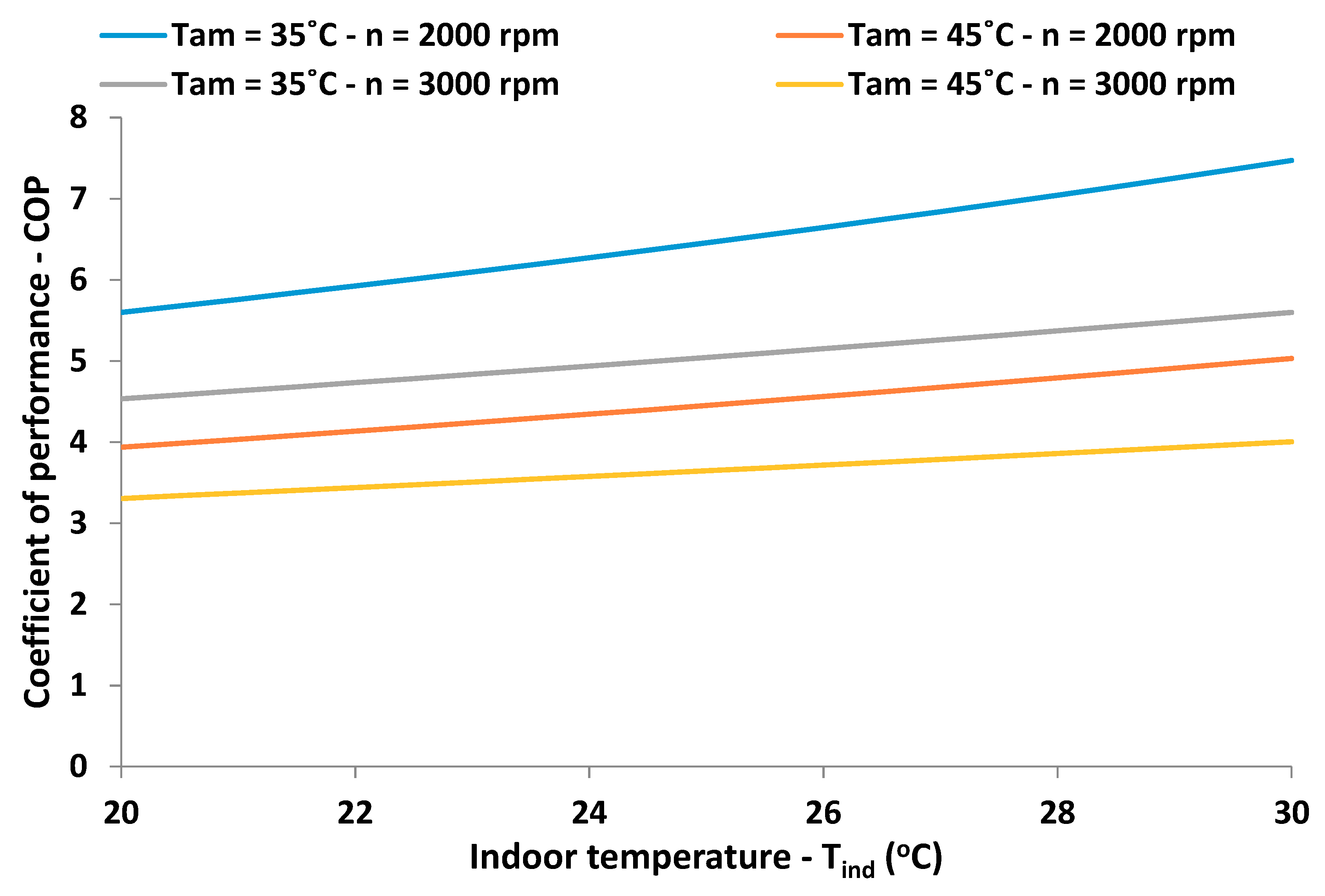
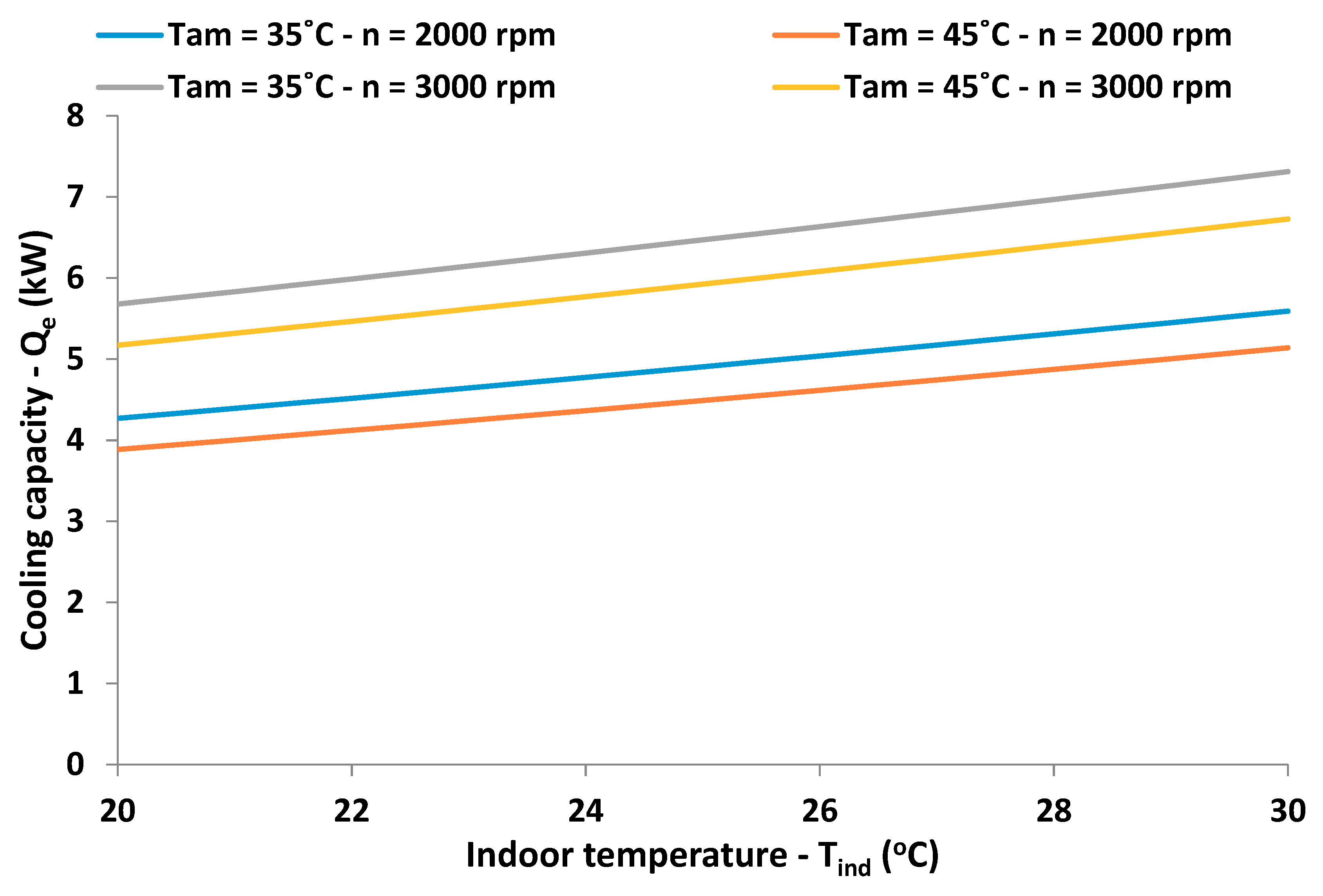
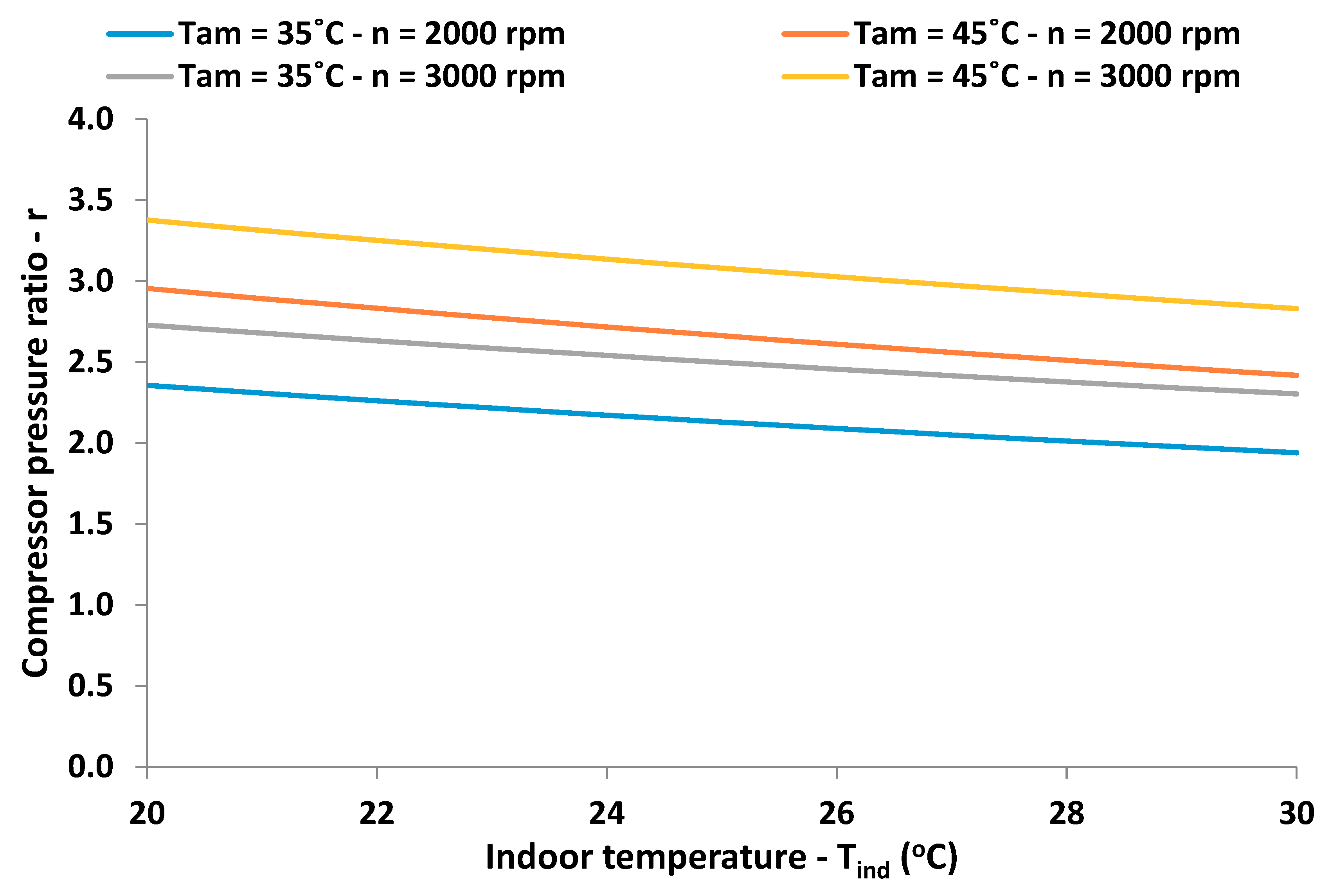
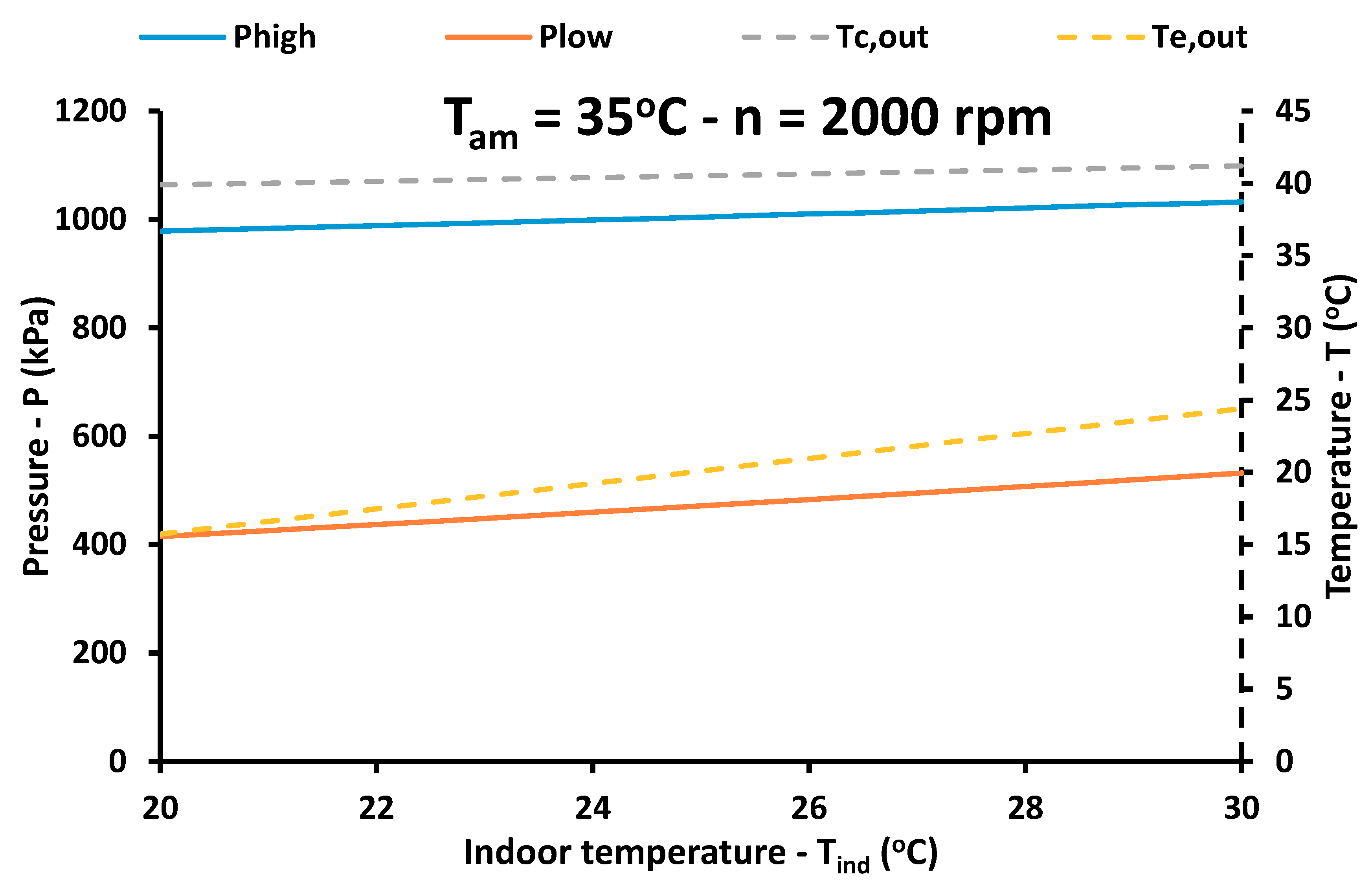
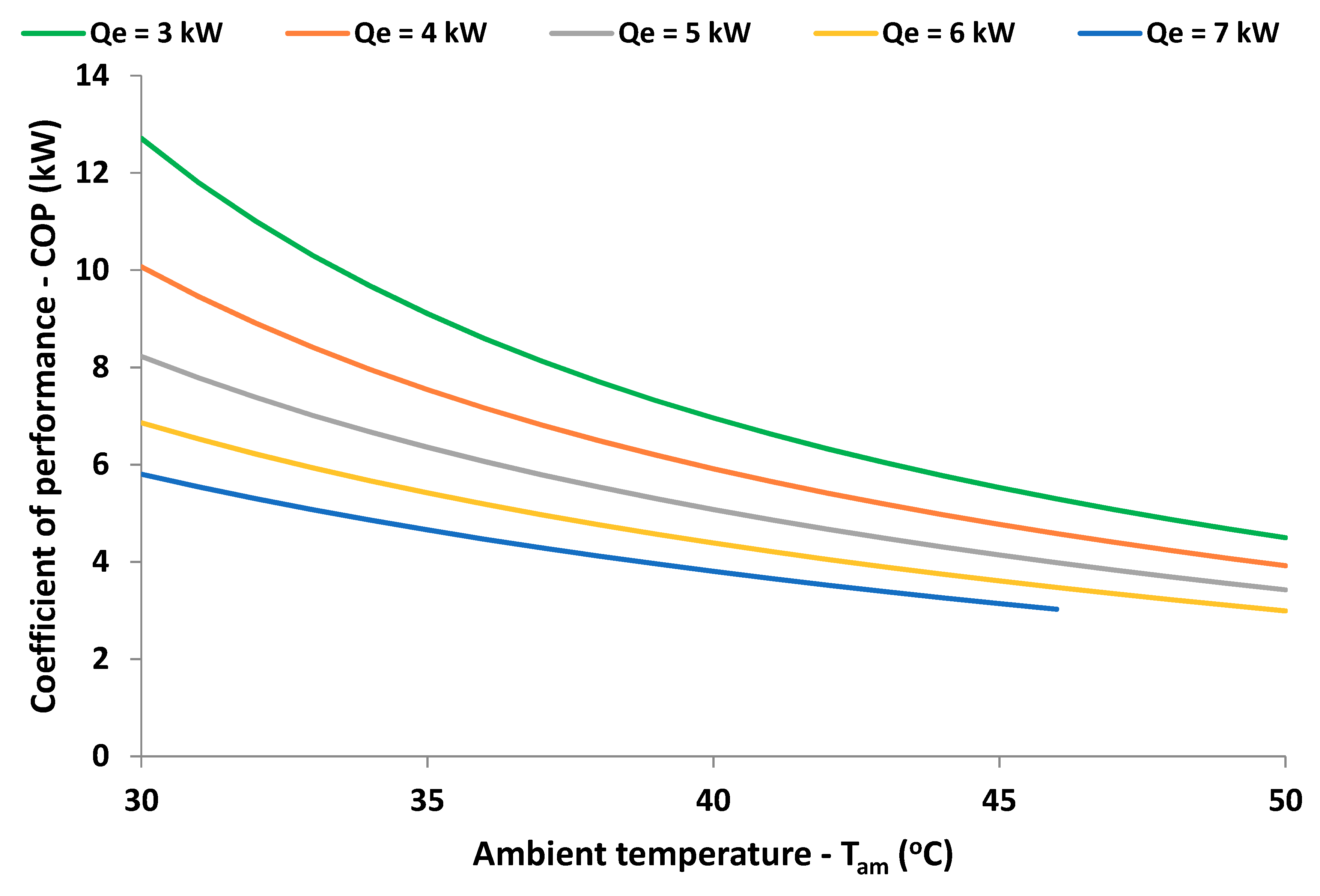
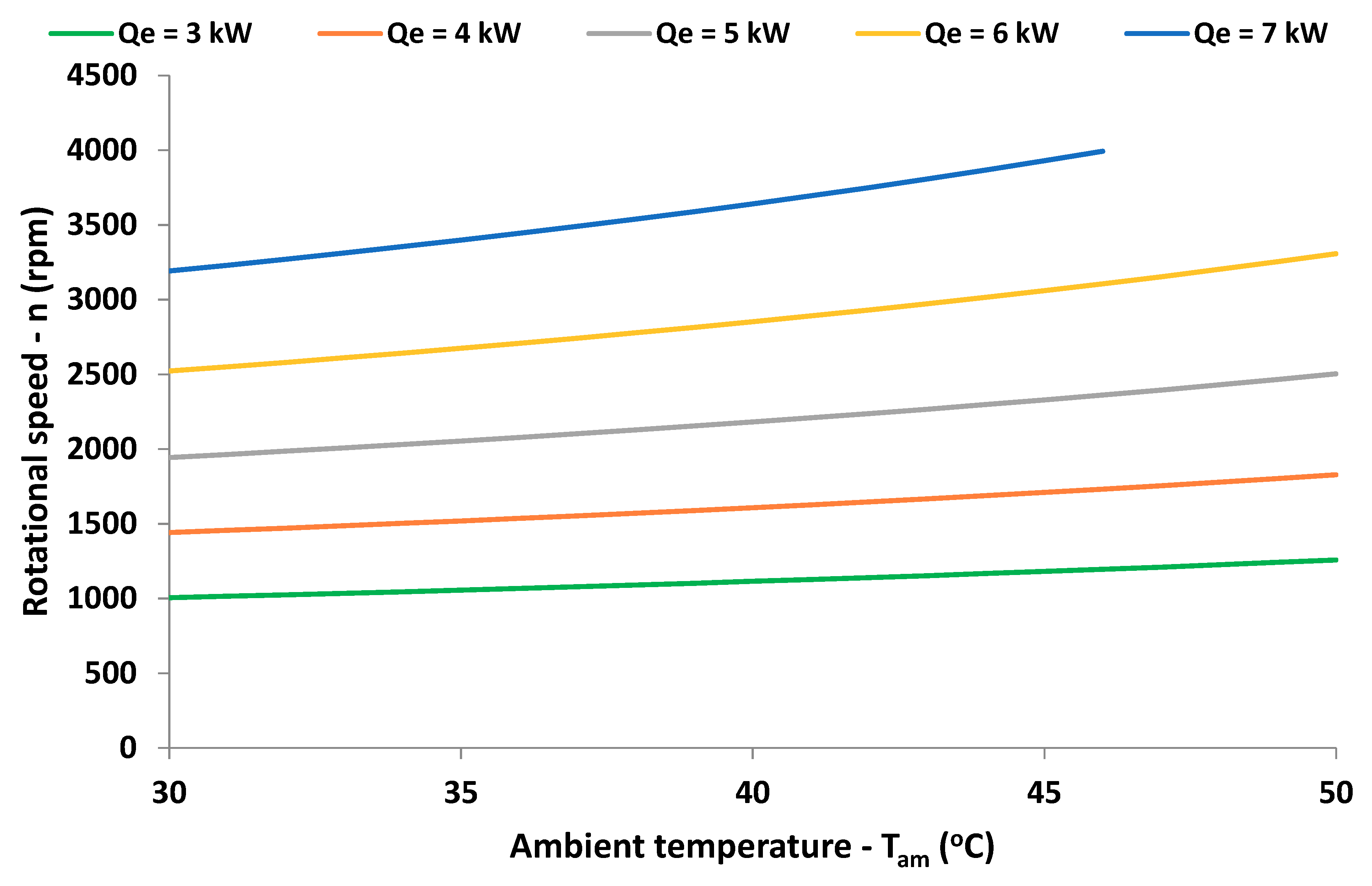
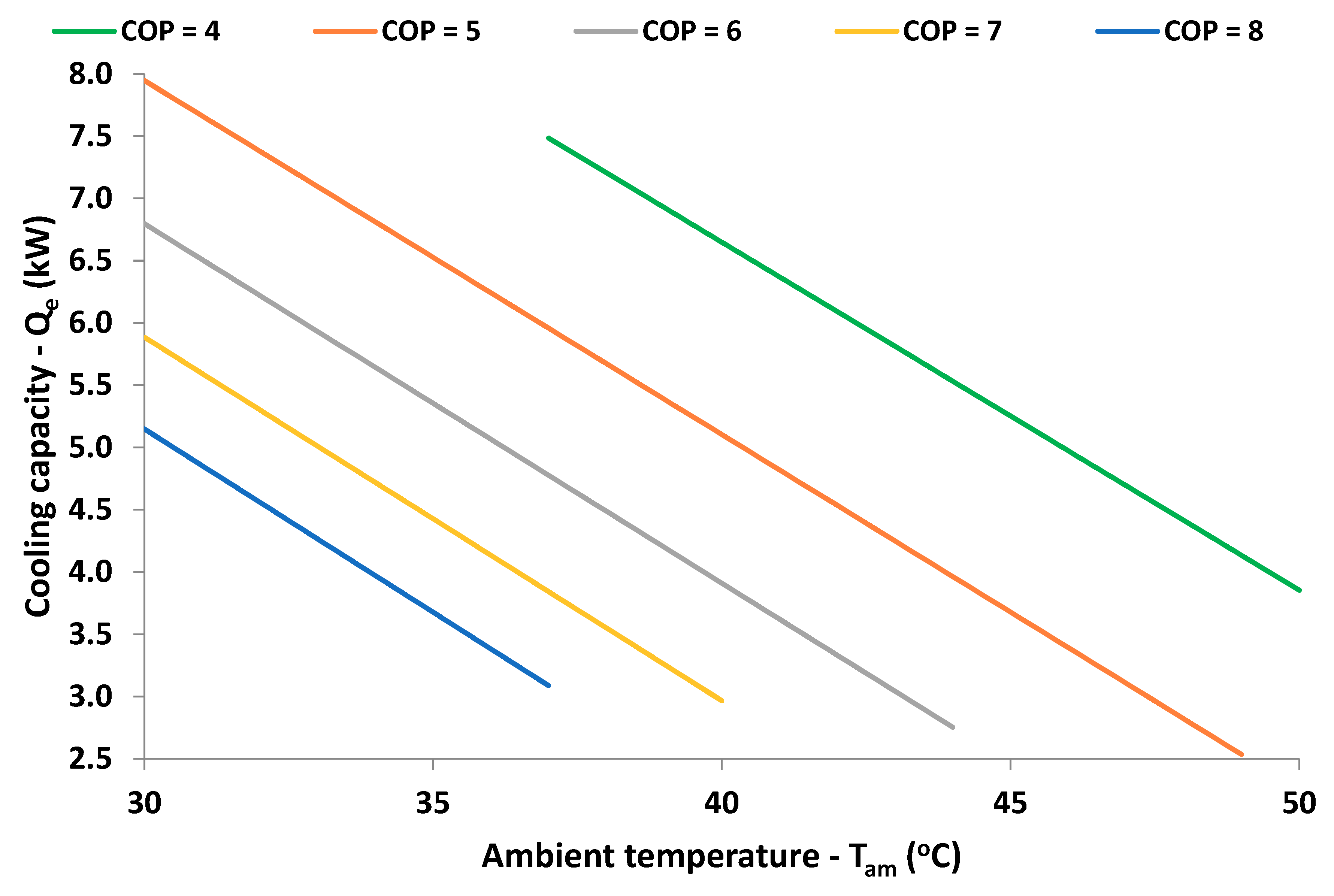

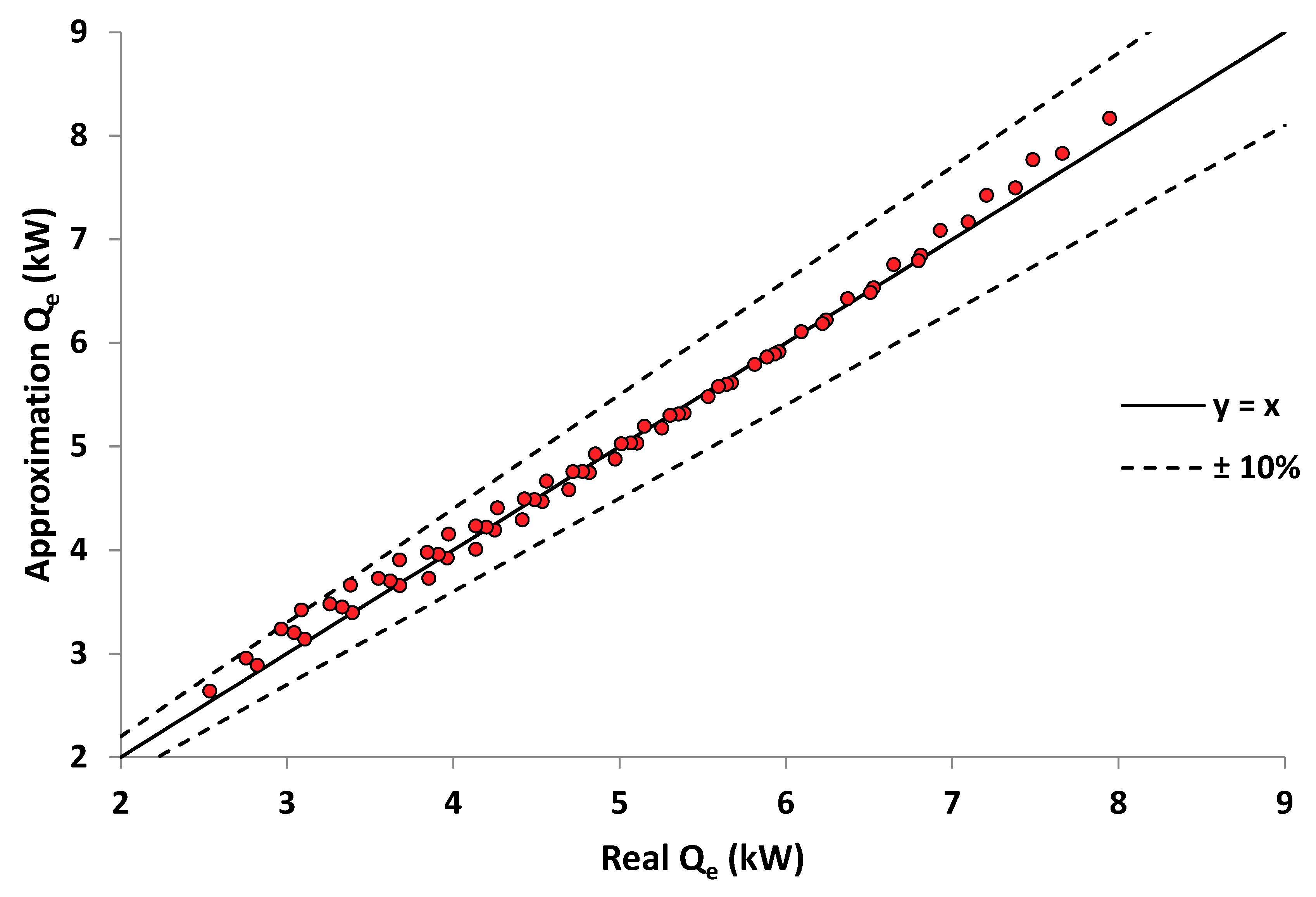
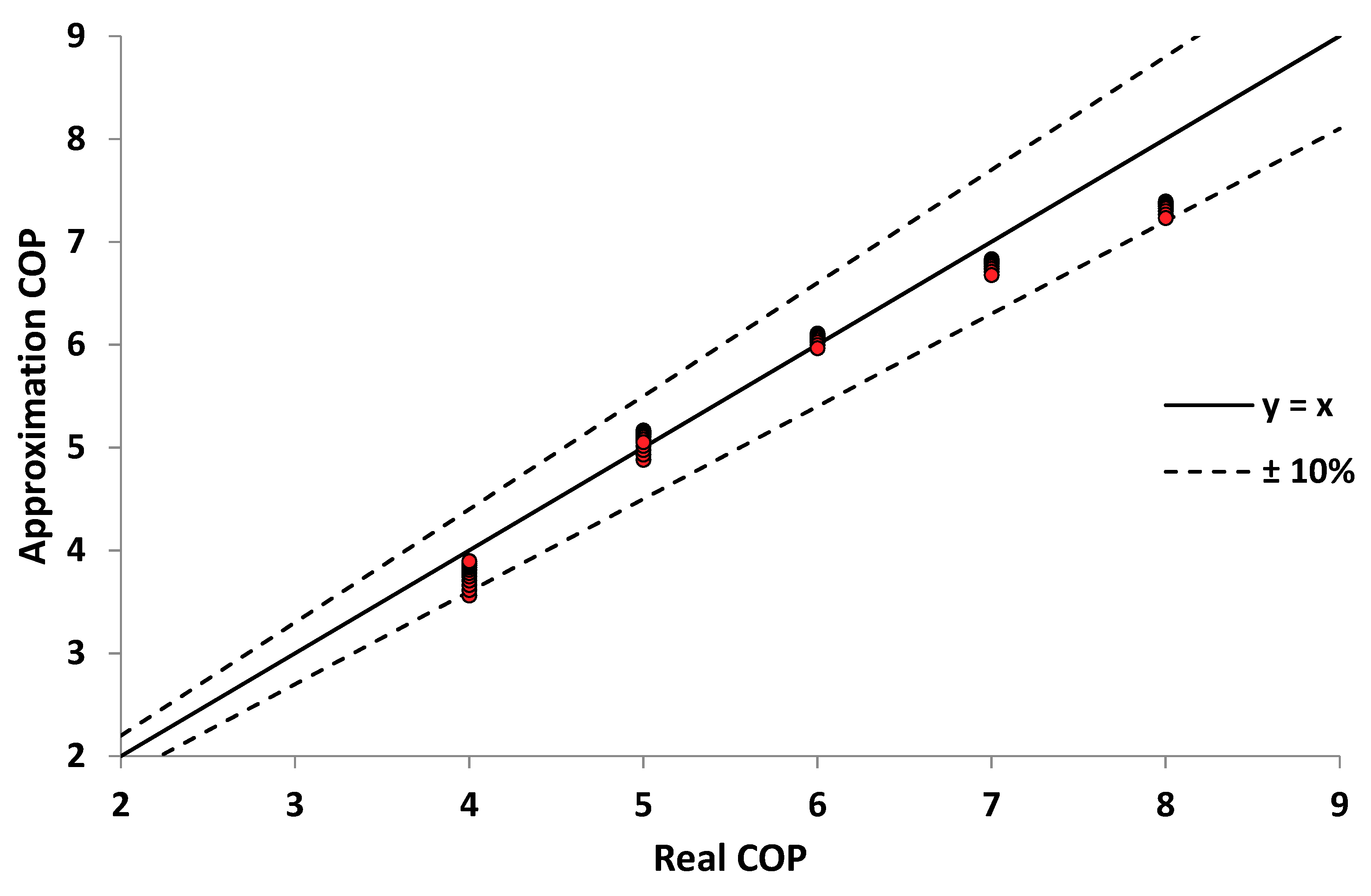
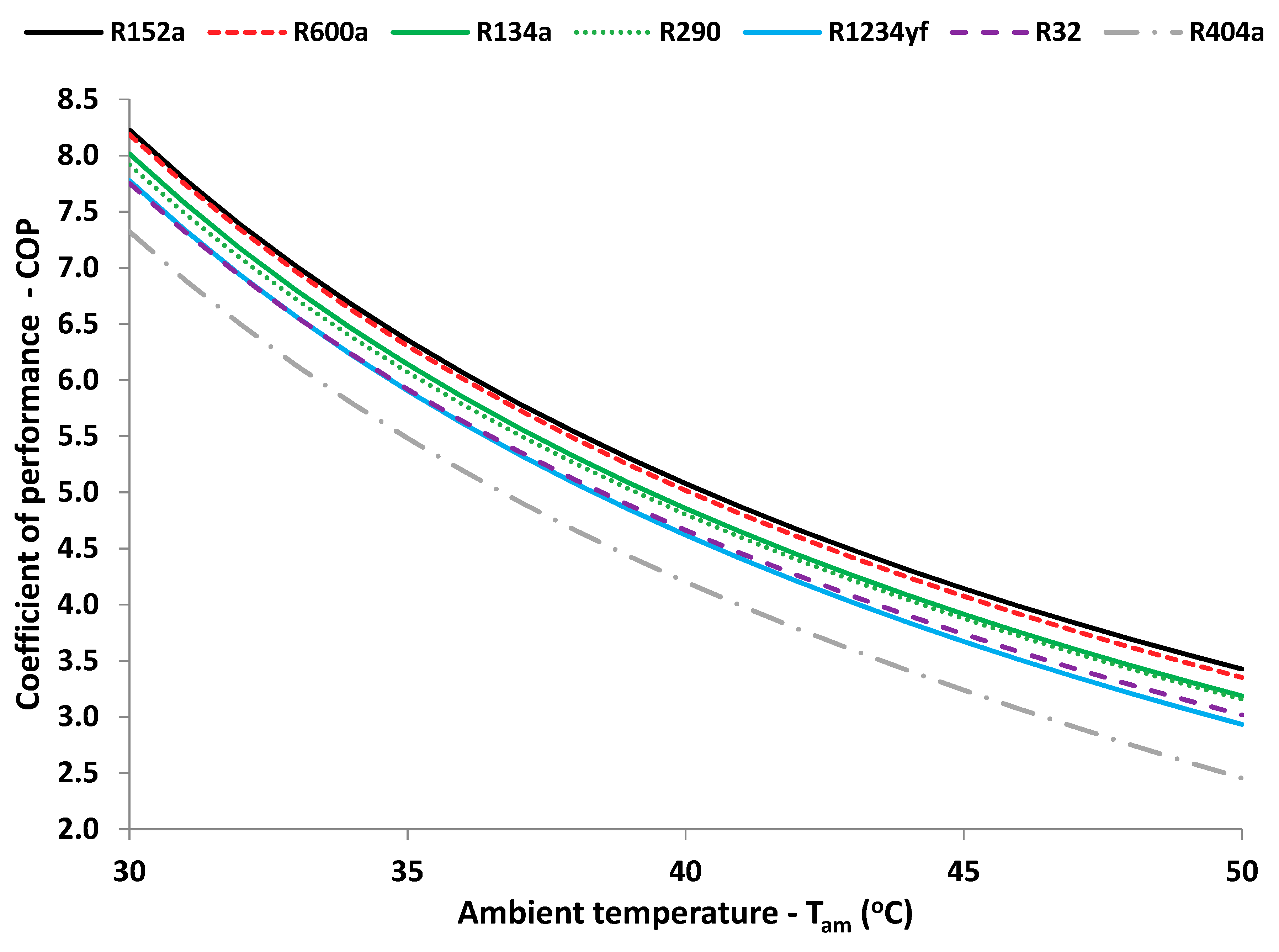
| Working Fluids | Classification | GWP | ASHRAE GROUP | Cost ($/kg) | Limitations |
|---|---|---|---|---|---|
| R134a | HFC | 1120 | A1 | 5.3 | High GWP |
| R404a | HFC | 3922 | A1 | 3.5 | High GWP |
| R152a | HFC | 138 | A2 | 1.5 | Medium flammability, Low GWP |
| R32 | HFC | 677 | A2L | 3.0 | Low flammability, Medium GWP |
| R1234yf | HFO | <1 | A2L | 88 | Low flammability, Stability issues |
| R1234ze | HFO | <1 | A2L | 90 | Low flammability, Stability issues |
| R717 (NH3) | Natural refrigerant | <1 | B1 | 1.5 | Toxicity |
| R744 (CO2) | Natural refrigerant | 1 | A1 | 0.7 | Low COP |
| R290 (Propane) | HC (Natural refrigerant) | 3 | A3 | 1.3 | High flammability |
| R600a (Iso-butane) | HC (Natural refrigerant) | 4 | A3 | 2.0 | High flammability |
| Parameter | Symbol | Value |
|---|---|---|
| Air mass flow rate in the condenser | mc | 1 kg/s |
| Air mass flow rate in the evaporator | me | 1 kg/s |
| Total transmittance in the condenser | (UA)c | 1000 W/K |
| Total transmittance in the evaporator | (UA)e | 1000 W/K |
| Motor mechanical efficiency | ηm | 80% |
| Compressor displacement volume | Vdis | 5∙10−5 m3/r |
| Nominal compressor rotational speed | n0 | 2000 rpm |
| Nominal ambient temperature | Tamb,0 | 35 °C |
| Nominal indoor temperature | Tind,0 | 25 °C |
| Nominal cooling capacity | Qe,0 | 5 kW |
| Nominal COP | COP0 | 6.46 |
| Parameter Investigation | Heating Production Temperature (Tc,out) | |||
|---|---|---|---|---|
| 45 °C | 50 °C | 55 °C | ||
| Qe (kW) | This work | 7.11 | 6.76 | 6.39 |
| Literature | 7.40 | 7.00 | 6.40 | |
| Deviation | 3.91% | 3.42% | 0.16% | |
| COPheating | This work | 3.46 | 3.09 | 2.77 |
| Literature | 3.64 | 3.12 | 2.67 | |
| Deviation | 4.95% | 0.96% | 3.75% | |
| Te,out (°C) | This work | 4.57 | 4.74 | 4.92 |
| Literature | 4.44 | 4.67 | 4.93 | |
| Deviation | 2.93% | 1.50% | 0.20% | |
| Te (°C) | This work | 2.49 | 2.69 | 3.27 |
| Literature | 2.41 | 2.64 | 3.21 | |
| Deviation | 4.98% | 1.89% | 1.87 | |
| Tc (°C) | This work | 47.58 | 52.58 | 57.58 |
| Literature | 47.60 | 52.60 | 57.60 | |
| Deviation | 0.04% | 0.04% | 0.03% | |
| Tamb (°C) | COP | ||||||
|---|---|---|---|---|---|---|---|
| R152a | R600a | R134a | R290 | R1234yf | R32 | R404a | |
| 30 | 8.227 | 8.186 | 8.014 | 7.916 | 7.776 | 7.752 | 7.322 |
| 31 | 7.786 | 7.742 | 7.573 | 7.481 | 7.336 | 7.32 | 6.89 |
| 32 | 7.383 | 7.337 | 7.169 | 7.083 | 6.933 | 6.925 | 6.495 |
| 33 | 7.012 | 6.964 | 6.798 | 6.718 | 6.563 | 6.562 | 6.13 |
| 34 | 6.671 | 6.621 | 6.456 | 6.381 | 6.221 | 6.228 | 5.794 |
| 35 | 6.356 | 6.303 | 6.140 | 6.07 | 5.905 | 5.918 | 5.482 |
| 36 | 6.064 | 6.009 | 5.847 | 5.781 | 5.612 | 5.631 | 5.192 |
| 37 | 5.791 | 5.735 | 5.574 | 5.511 | 5.338 | 5.364 | 4.92 |
| 38 | 5.538 | 5.479 | 5.319 | 5.26 | 5.083 | 5.114 | 4.666 |
| 39 | 5.300 | 5.240 | 5.080 | 5.025 | 4.843 | 4.881 | 4.427 |
| 40 | 5.078 | 5.016 | 4.856 | 4.804 | 4.619 | 4.662 | 4.202 |
| 41 | 4.868 | 4.805 | 4.646 | 4.597 | 4.407 | 4.455 | 3.989 |
| 42 | 4.671 | 4.607 | 4.447 | 4.401 | 4.208 | 4.261 | 3.787 |
| 43 | 4.486 | 4.419 | 4.26 | 4.216 | 4.019 | 4.077 | 3.596 |
| 44 | 4.310 | 4.242 | 4.082 | 4.041 | 3.84 | 3.902 | 3.413 |
| 45 | 4.143 | 4.074 | 3.914 | 3.875 | 3.67 | 3.737 | 3.238 |
| 46 | 3.985 | 3.915 | 3.754 | 3.718 | 3.509 | 3.579 | 3.07 |
| 47 | 3.835 | 3.764 | 3.602 | 3.568 | 3.355 | 3.429 | 2.908 |
| 48 | 3.692 | 3.62 | 3.457 | 3.425 | 3.208 | 3.286 | 2.752 |
| 49 | 3.556 | 3.482 | 3.319 | 3.288 | 3.068 | 3.149 | 2.601 |
| 50 | 3.426 | 3.351 | 3.187 | 3.157 | 2.933 | 3.017 | 2.454 |
| Mean COP | 5.342 | 5.2815 | 5.119 | 5.063 | 4.8784 | 4.917 | 4.444 |
| Enhancement | 1.14% | 4.36% | 5.51% | 9.50% | 8.65% | 20.20% | |
© 2018 by the authors. Licensee MDPI, Basel, Switzerland. This article is an open access article distributed under the terms and conditions of the Creative Commons Attribution (CC BY) license (http://creativecommons.org/licenses/by/4.0/).
Share and Cite
Bellos, E.; Tzivanidis, C. Investigation of the Environmentally-Friendly Refrigerant R152a for Air Conditioning Purposes. Appl. Sci. 2019, 9, 119. https://doi.org/10.3390/app9010119
Bellos E, Tzivanidis C. Investigation of the Environmentally-Friendly Refrigerant R152a for Air Conditioning Purposes. Applied Sciences. 2019; 9(1):119. https://doi.org/10.3390/app9010119
Chicago/Turabian StyleBellos, Evangelos, and Christos Tzivanidis. 2019. "Investigation of the Environmentally-Friendly Refrigerant R152a for Air Conditioning Purposes" Applied Sciences 9, no. 1: 119. https://doi.org/10.3390/app9010119
APA StyleBellos, E., & Tzivanidis, C. (2019). Investigation of the Environmentally-Friendly Refrigerant R152a for Air Conditioning Purposes. Applied Sciences, 9(1), 119. https://doi.org/10.3390/app9010119






